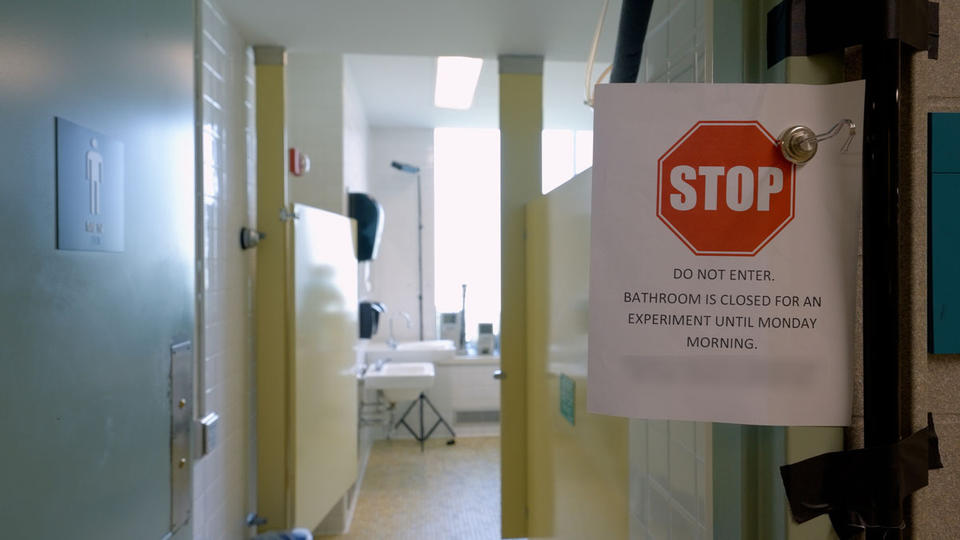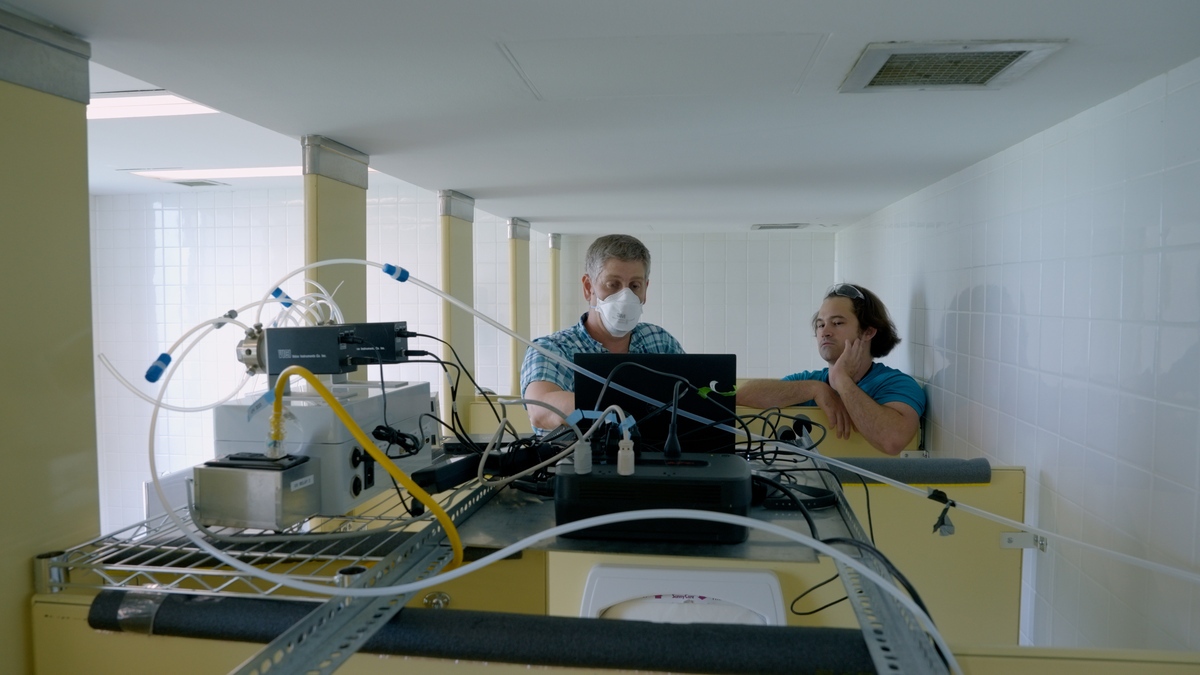- Air in public bathrooms can contain chemicals that react with ozone, producing air pollution.
- Air sanitizers that use one type of ultraviolet light produce ozone that could kick-start those chemical reactions.
- Further research is needed to understand how to minimize these unintended byproducts of ultraviolet light.

NIST indoor air quality researchers closed a men’s restroom over two weekends to measure indoor air pollution caused by UV air sanitizers.
For most people, a smelly bathroom is something to avoid. But when the ventilation stopped working in his lab’s hallway bathroom, indoor air expert Michael Link smelled opportunity.
At the National Institute of Standards and Technology (NIST), Link and his colleague Dustin Poppendieck study air sanitizers that use ultraviolet light (UV). These devices kill pathogens such as those that cause the flu and COVID-19, but they can also cause unintended chemical reactions in the air.
Link and Poppendieck wanted to know what those reactions looked like in the complex chemical soup of a real restroom. Their latest research, published in Environmental Science: Processes & Impacts, shows that these reactions produce pollutants that could be a health risk. As these sanitizers make their way into our homes and buildings, this research could help guide decisions on using them.
A New Kind of UV
When the COVID-19 pandemic began, people started looking for effective ways to control airborne disease in indoor spaces. One promising approach was to use UV radiation. UV is light, but with a wavelength too short for our eyes to detect. Red light has a wavelength of about 700 nanometers (nm); yellow light, 580 nm; and ultraviolet light is between 400 and 100 nms. The shorter the wavelength, the higher the energy. UV light has enough energy to break apart DNA, which is why it’s effective at killing viruses in the air (and why you should wear sunscreen at the beach).
UV air sanitizers were first widely used in the 1950s to combat tuberculosis. Those early attempts used UV with a wavelength of 254 nm, because that energy level is the most effective at breaking apart DNA and killing pathogens. It is still the most common type of UV air sanitation.
But there’s a drawback to this high-energy UV; it can cause sunburn or temporary blindness. It has to be directed away from people, while still shining on the air they breathe. To use this UV safely, installers must position the lights carefully within ventilation shafts or point them toward the ceiling. This challenge of positioning UV sources is one of the main reasons this form of air purification isn’t used more widely. To avoid that risk, there has been a lot of interest in using less-damaging UV light.
UV light with a wavelength of 222 nm is still effective at killing pathogens, but the shorter wavelength doesn’t penetrate as deeply into human skin, so it’s safe to shine directly on people. Because of this, 222 nm UV light could be used to sanitize the air in small, crowded places like classrooms, elevators and public transportation, places where 254 nm UV sanitizers would be difficult to install easily.
But this wavelength has its own unique drawback: It turns oxygen in the air into ozone. Ozone itself can be concerning, and it is also highly reactive with other chemicals in the air and creates new secondary compounds. Link and Poppendieck wanted to know whether the new chemicals could pose a health risk.
The Experiment
In the carefully controlled environment of a lab, researchers can precisely measure air chemistry. But people don’t live in stainless steel lab chambers. “Standard lab tests only measure how ozone reacts with one or two pure chemicals,” Poppendieck explained. “In the real world, indoor air has tens if not hundreds of different chemicals that could potentially react in significant concentrations. Michael Link and I talked it over, and he suggested we run a real-world test to help us understand whether these lights are safe.”
They decided to set up their study in a men’s restroom because it had urinal screens — those brightly colored pads placed over the drain to prevent splashing. These screens release fragrances (to mask the odor of urine) that include terpenes, a group of chemicals that reacts strongly with ozone. This study primarily focused on terpenes, but most bathrooms have air filled with chemicals such as cleaners and other scented hygiene products that would also react with ozone.

The team installed 222 nm UV sanitizers in the bathroom along with a suite of chemical sensors. “I've never installed state-of-the-art air quality measuring devices in a bathroom,” said Link, first author on the study and patron of the laboratory lavatory. “We had to figure out how to get enough power into the bathroom for these instruments. We had to make sure we had a wireless internet connection so we could monitor our instruments in real time. We even had to consider things like not dropping electrical cords into the toilet.”
After analyzing their results collected over two weekends — one with ventilation and one without — they found that the 222 nm UV light was producing enough ozone to react with chemicals in the air. The byproducts included formaldehyde, volatile organic compounds and nanoparticles.
To fully understand the importance of these chemical byproducts, researchers will need to conduct additional studies to determine how dangerous these pollutants might be, including on a wide variety of indoor spaces and environments that could benefit from the use of UV sanitizers. Other environments are expected to create different kinds of chemicals at different rates, and ventilation could affect how long they will stick around in the air.
Ultimately these studies could be used to develop tests for UV air purifiers and guidelines for how to minimize their production of volatile chemicals. This information could ultimately guide decisions on how to best deploy UV sanitizers in a wide range of settings to optimize their benefits to human health.
Paper: Michael F. Link, Rileigh L. Robertson, Andrew Shore, Behrang H. Hamadani, Christina E. Cecelski and Dustin G. Poppendieck. Ozone generation and chemistry from 222 nm germicidal ultraviolet light in a fragrant restroom. Environmental Science: Processes & Impacts. Published online May 20, 2024. DOI: 10.1039/D4EM00144C

